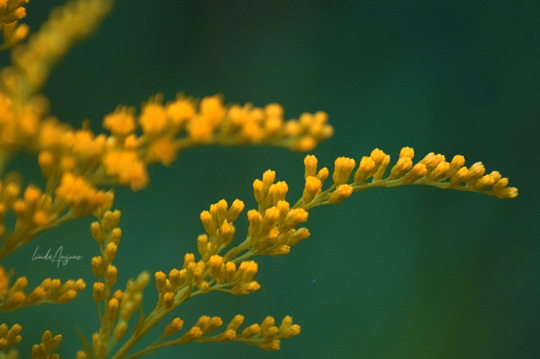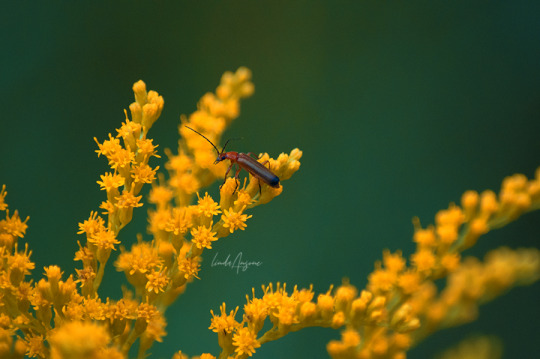#Rhagonycha fulva
Explore tagged Tumblr posts
Text

Red Soldier Beetle
A red soldier beetle feeding on an ox-eye daisy flower, at Grafham Water.
#beetle#beetles#cambridgeshire#canon#canonuk#common red soldier beetle#grafham#grafham water#insect#insects#invertebrate#invertebrates#minibeast#minibeasts#nature#nature reserve#outdoors#red soldier beetle#rhagonycha fulva#soldier beetle#wildlife#wildlife trust#wildlife trusts
53 notes
·
View notes
Video
Lepture et "Rhagonycha fulva" sur achillée millefeuille par brigitte lagravaire Via Flickr : 2016-07-05-Madaillan (13)
#FB#été#fleur blanche#flou#flore sauvage#blanc#Lot-et-Garonne#Aquitaine#Pays de Serres#coléoptère#coléoptère rouge#sans retouche#achillée millefeuille#Daucus carota#Rhagonycha fulva#bokeh#lepture#FF47#LCOB#insecte#animal#faune#nature#juillet#BLALB#France Sud-Ouest#20160705#TUMBLR#flickr
0 notes
Text

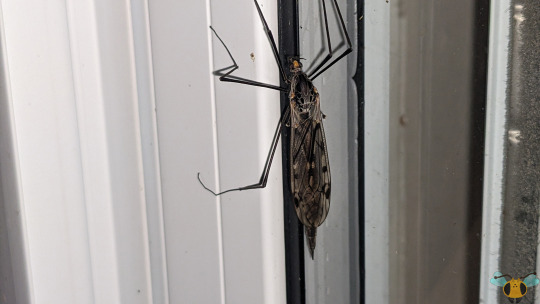







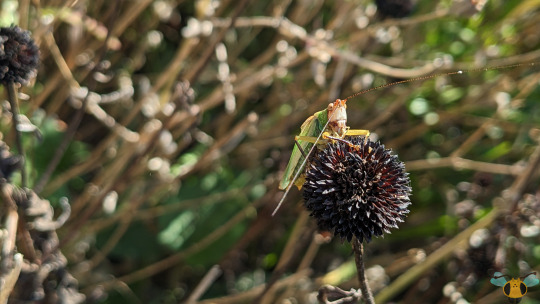
Insect Highlights of 2024
With the new year celebrations scheduled for this weekend, I thought it best to share some of my favorite insect specimens from this year, rather than one single typed of insect. The pictures here haven't been uploaded to the blog in a post, so today they can all share the spotlight. There are many familiar faces here and all of them are incredible and beautiful creatures. Hopefully there are even more insect delights and finds to enjoy in the upcoming year. To ring in the new year, we have the following insects:
Four-Spotted Skimmer - Libellula quadrimaculata - Order Odonata (May 24th)
Giant Crane Fly - Tipula metacomet - Order Diptera (September 16th)
Spring Fishfly - Chauliodes rastricornis - Order Megaloptera (May 27th - from Muskoka)
Milkweed Aphids - Aphis nerii - Order Hemiptera (September 3rd - alongside German Yellowjackets)
Oil Beetle - Meloe campanicollis - Order Coleoptera (October 21st)
Fall Webworm Caterpillars - Hyphantria cunea - Order Lepidoptera (July 25th)
Great Golden Digger Wasp - Sphex ichneumoneus - Order Hymenoptera (July 1st)
European Earwig - Forficula auricularia - Order Dermaptera (September 21st)
Common Red Soldier Beetle - Rhagonycha fulva - Order Coleoptera (July 1st)
Black-Legged Meadow Katydid - Orchelimum nigripes - Order Orthoptera (October 27)
All pictures here were taken in 2024 with a Google Pixel 4.
Wishing everyone a Happy New Year and a marvelous 2025! Thank you everyone for making this another beautiful year of insect observations! I hope to reach even more of you this year with many more wonderful insect pictures and videos. Enjoy your celebrations!
#jonny’s insect catalogue#happy new year#dragonfly#fishfly#earwig#caterpillar#katydid#aphid#beetle#wasp#giant crane fly#oil beetle#four spotted skimmer#european earwig#milkweed aphid#spring fishfly#black legged meadow katydid#fall webworm caterpillar#great golden digger wasp#common red soldier beetle#ontario insect#fly#toronto#2024#happy new year 2025#yearly insect highlights#fall webworm moth caterpillar#tipula metacomet
20 notes
·
View notes
Text

A common red soldier beetle - Rhagonycha fulva - enjoying some marsh thistle.
16 notes
·
View notes
Text


Common Red Soldier Beetle (Rhagonycha fulva) and his face
Levenhuk 720B x Nikon D5600 × AF-P DX 18–55 VR
13 notes
·
View notes
Note
Do you happen to know what species of bug this little guy is?


I don't think I've seen it before. If it helps, I saw it flying around.
That looks like a soldier beetle, possibly Rhagonycha fulva or Cantharis livida!
R. fulva is quite common in Europe and parts of Canada, but if that isn't where you've seen this guy it's probably C. livida. :-D
I'm having super great fun identifying bugs, so if you ever have another one for me, ask ahead! :-)
9 notes
·
View notes
Note
is there a word for beetle in clanmew ? realizing that uhh. my man beetlestalk cant introduce himself atm LAWL /silly
There's a few and it depends on the sort of beetle! See, there's three general 'classes' of beetle, which they would have words for.
ROUND, STINKY Beetle = "Owssub"
We're talking ladybugs (Coccinella septempunctata), bloodnoses (Timarcha tenebricosa), and some insects that Clan cats would class as beetles like shieldbugs. All fat, oval or circular bugs are in this category.
Not all of them actively spray attackers, but it's enough of a problem that all Owssub are treated with caution. It's thought all of them can, but some of them are just docile.
THIN, LONG beetle = "Lebub"
Red soldier beetles (Rhagonycha fulva), all types of longhorn beetle, musk beetles (Aromia moschata), click beetles, etc.
Most of these are safe to eat and relatively harmless, though musk beetles can be stinky. So this would be the softer, cuter term.
BITE Beetle = "Gnombub"
Rove beetles, tiger beetles, and earwigs (Forficula auricularia) though they aren't proper beetles.
All members of this species are seen as formidable hunters and honorable foes, bravely standing against cats many times their size. They're adored and respected as animals by Clan cats.
The Green Tiger Beetle (Cicindela campestris), and the Devil's Coachhorse (Ocypus olens) have unique names of their own-- Holrokach and Uboraor. Green-Claw and Black-Tiger. It's related to the basis of the TigerClan myths. This, plus the legend's association with tabby patterns caused the translator to make "gaor" into "tiger" to match leopards and lions.
Below the spoiler is a real beetle with a big butt. Booty Beetle, if you will.

[Id: A green beetle with thick butt cheeks. Oedemera nobilis]
#Clanmew#Clanmew expansion pack#I'll get around to the other great clans at some point I swear#But man TigerClan actually being bug-related sparks joy within me
42 notes
·
View notes
Text


Long hoverfly(Sphaerophoria scripta), Red soldier beetle(Rhagonycha fulva) and Yellow-Masked bees(Hylaeus) eating nectar from our onions
#wildlife#nature#flowers#bees#beetleposting#hoverfly#onion#vegetables#photography#insects#plants#my photos#my photography
2 notes
·
View notes
Text

Feeding Soldier Beetle
A common red soldier beetle feeding on fennel flowers, in Twywell Gullet.
#canon#canonuk#common red soldier beetle#insect#insects#invertebrate#invertebrates#minibeast#minibeasts#nature#nature reserve#northamptonshire#northants#outdoors#rhagonycha fulva#summer#twywell#twywell gullet#twywell plantation#wildlife#wood#woodland#woodland trust#woods
1 note
·
View note
Text
"JULY 12. High summer and one can hear the universe; so overwhelming is the accumulated sound of growing in the meadow and in hedges, of pollen being released, of particles moving in heat, that all the minute motions together create a continuous hum: the sound of summer.
Meanwhile the swifts tear the fabric of the sky on scything wings. The yarrow flowers are tall, the hawthorn flowers have turned to hard green haws. Blackfly fasten on thistles, so too slender marmalade soldier beetles (Rhagonycha fulva) mating, tail to tail."
~ John Lewis-Stemple, Meadowland: The Private Life of an English Field
#john lewis stempel#john lewis-stempel#quotes#nature quotes#nature writing#july quotes#lit quotes#summer quotes
11 notes
·
View notes
Text
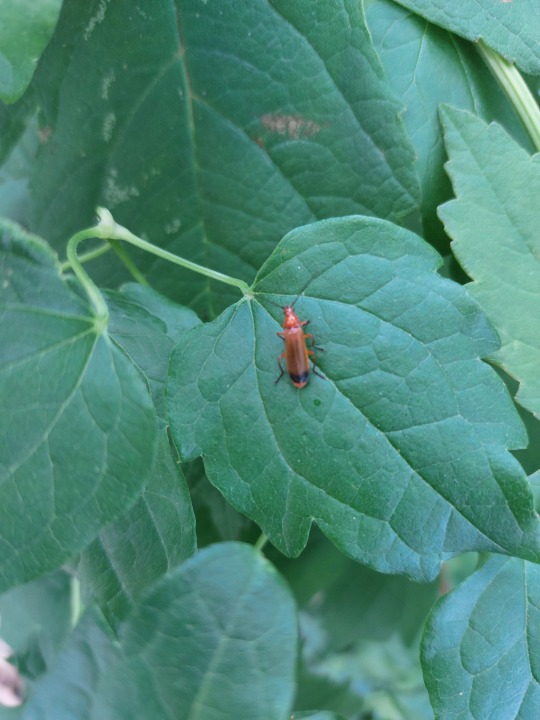
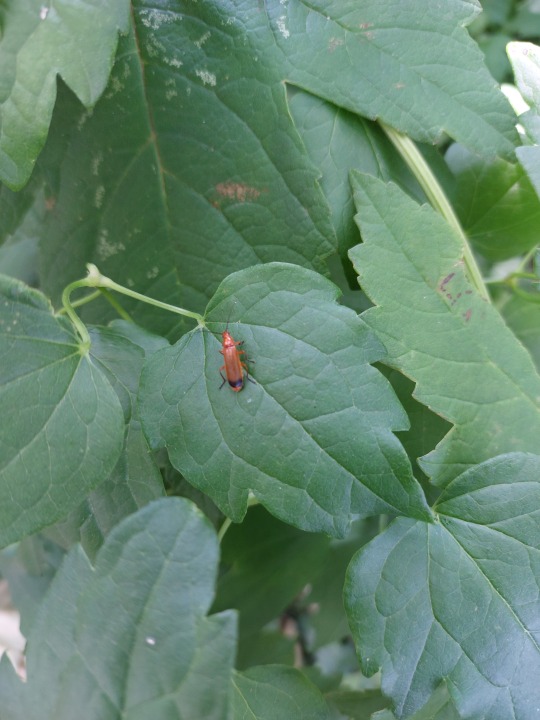

Rhagonycha Fulva ;
Common red soldier beetle ♥
15 notes
·
View notes
Text
Common red soldier beetles (Rhagonycha fulva) photos I took on Thursday, West Yorkshire, UK
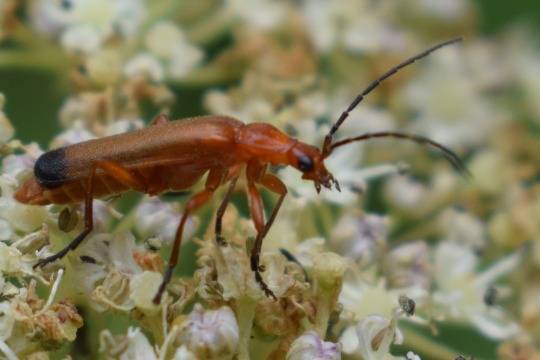
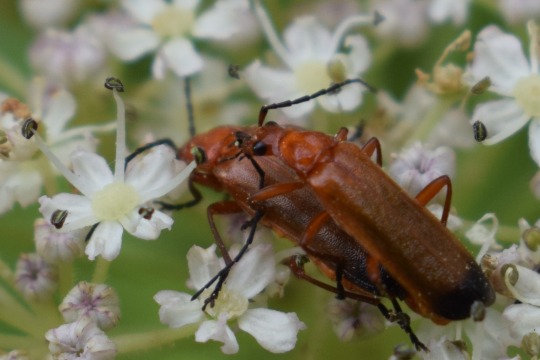
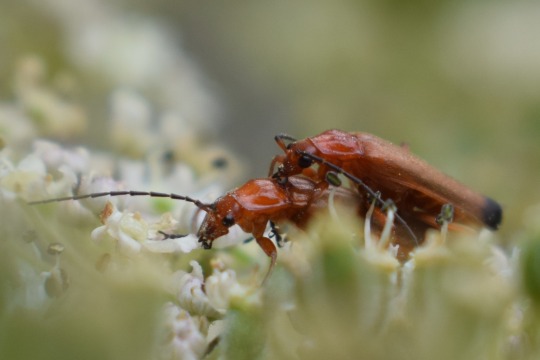
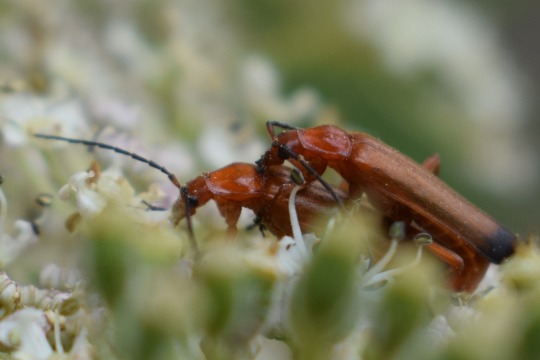
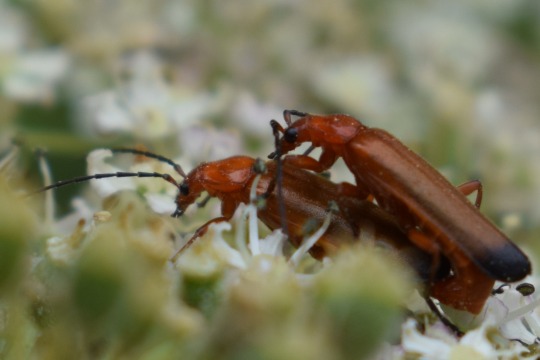
#nature#nature photography#animal#animals#wildlife#animal photography#wildlife photography#british nature#beetle#beetles#soldier beetle#insect photography#insect#invertebrate#invertebrates#insects#entomology#bug photography#bugblr#bugs#bug#wild#wild animal#wild animals#british wildlife#wild planet#macro#macro photography#macro captures#wild photography
8 notes
·
View notes
Text










Common Red Soldier Beetle - Rhagonycha fulva
Just like a few years ago, a small section of partial wilderness in my neighborhood continues to play host to many mating pairs of Common Red Solider Beetle. When otherwise unoccupied, these diligent insects will crawl along and fly among the many flowers and buds here (including thistle buds). While some individuals are keen to hang around, dozens of individuals in this area were on patrol for soft-bodied insects to eat, such as small Caterpillars and Aphids. That in mind, the Plagiognathus Plant Bug specie seen in Pictures 1, 4 and 7 shouldn't let its guard down completely. This is of course, adult behavior, as the larvae of this Soldier Beetle feed on other plant-visiting animals such as hungry mollusks. As they visit flowers, it's worth mentioning that the diet of the adults also includes nectar and pollen, hence them diving headfirst into some of these flowers. Based on these pictures, I'm mindful of a point I brought in the previous point, where I wondered how/if these insects could serve as pollinating insects. Research supports that these Beetles play a role in pollination of certain flowers, but I wonder how that role varies across different types of flowers.
Flowers come in all shapes, sizes and configurations, and all area designed to work with some range of pollinators. So how might our Common Red friends here potentially pollinate the more open faced flowers and tipped thistle flowers in these images? The Beetle's bodies don't appear as suited for the adherence and transfer of pollen (compared to other pollinators), but they don't make direct contact with the flower's face. With how the insect travels, pollen may be transferred if some bits are caught on the Beetle's feet or from their mandibles as they go in for a nectar reward. Honestly, I think I'll need to revisit these Beetles next year when they return during the summer months. When I do, I'll observe them more carefully and see where pollen collects along their body and see how it makes contact with another flower. Regretfully, while they were many to behold when I photographed them, there were far less 2 weeks later, as their adult lives aren't long. Do not misunderstand however, these Beetles can be seen as adults all summer long, so some individuals may be airborne for a month or so, and securing mates when possible. And as it was before, the females continue to be distinctly larger than the males.
Pictures were taken on July 1, 2024 with a Google Pixel 4.
#jonny’s insect catalogue#ontario insect#beetle#common red soldier beetle#soldier beetle#coleoptera#insect#toronto#july2024#2024#mating pair#nature#entomology#invertebrates#arthropods#photography#animals#plagiognathus#plagiognathus plant bug#plagiognathus bug
10 notes
·
View notes
Text
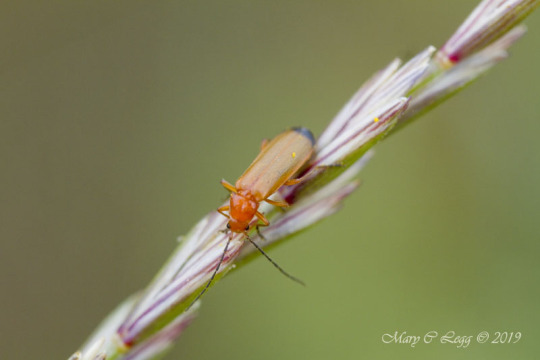
Common Red Soldier Beetle, Rhagonycha fulva Canon 7D EFS 60 2.8 f/4 1/320 iso 200 Srbsko, Czech Republic 7/11/2019
#beetles#soldierBeetles#bonkingBeetles#Cantharidae#Coleoptera#insects#Macro#Grasslands#macrophotography#insectphotography#invertebrates#insect#canon
5 notes
·
View notes
Video
youtube
Rhagonycha Fulva - The Red Soldier Beetle
0 notes

